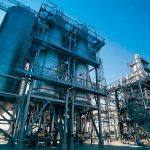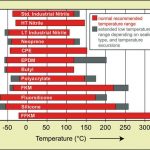To increase mean time between failure (MTBF), improve safety and reduce leaks, system and maintenance engineers must match a seal material’s performance and cost to process conditions. In the following the options available are reviewed and useful details to help to make the right choice are given.
William M. Stahl
There are over twenty classes of natural and synthetic elastomers. They share common characteristics including elastic recovery after stress, flexibility, extrusion resistance and relative impermeability to gases and liquids, but each also has its own unique properties that can be modified by other ingredients. Elastomers are usually formulated by compounders to present specific engineering properties for an application. With the wide choice of materials available, it is important for seal specifiers to consult with the seal manufacturer to determine the right elastomer for the application. SAE J200 (ASTM D2000) describes a classification system for specifying rubber products. It positions elastomers according to resistance to heat ageing and swelling in oil. To predict chemical and thermal resistance in hostile chemical process environments it is necessary to rely on field experience, laboratory testing and guidance from material experts.
Elastomer properties
Elastomers are rated for compatibility with various media including fluids, weather and ozone. In a fluid environment elastomers may swell or react chemically with the fluid, causing changes in the polymer structure, and solubles may be extracted leading to a decrease in volume. Generally, below 5 to 10 % swell is considered excellent. Although swelling is a key criterion for assessing part compatibility, other properties should be measured as well. The mechanical properties of an elastomer will generally change after prolonged exposure to high temperatures. Natural rubber, for example, will become gummy whereas polychloroprene slowly hardens. Relatively small changes in temperature may cause large differences in the degree of deterioration. Heat ageing tests are usually based on 70-hour exposure in thermally controlled hot air. In critical applications, engineers should consult with the part manufacturers to see if long-term exposure in a particular medium has been evaluated. In addition, tests should be performed under conditions that closely mirror the actual process conditions.
Mechanical properties that influence elastomer performance include compression set, tensile strength, elongation, hardness and abrasion resistance. Most can be modified through the compounding process to impart the required characteristics. Other properties to consider in specific applications include weathering – cracking, peeling, chalking, colour changes and other surface defects that may lead to failure can occur when elastomers are exposed to weather and ozone. Synthetic elastomers are inherently more resistant than natural rubber. Permeability is a measure of the ease with which a liquid, vapour or gas can pass through an elastomer and is important in many applications, including gaskets, seals and diaphragms.
Selection criteria
When selecting sealing materials, seal life and maintenance costs must be taken into account. The guiding principle should be value in use. Specifying the appropriate seal can also prevent costly unscheduled downtime and dangerous leakage, as the sum of the costs related to the quality and durability of the installed seal usually far outweigh its purchase price. The following important selection criteria should be considered as well:
- Fluid to be sealed, including any contaminants or additives
- Minimum and maximum temperature range, thermal cycling and potential excursions
- Minimum and maximum pressure range and compression/decompression rate
- Motion, either static or dynamic
- Need for lot sampling
- Acceptable quality levels (AQLs)
- Critical sealing surface
Enhanced product range
DuPont Performance Elastomers’ Chemical Resistance Guide helps to choose the best elastomer for given application conditions. It is available online free of charge at www.dupontelastomers.com and rates the performance of 20 elastomers in over 1,000 chemicals at room temperature.
The regulatory demands on the industry are driving manufacturers towards cost-efficient environmental solutions. A European directive on Integrated Pollution Prevention and Control will be introduced in October 2007, when process plants will be compelled to reduce the loss of volatile organic compounds through unexpected leaks, evaporation, flaring or spills (IPPC, 96/61/EU). In response to the increasing requirements of pump manufacturers and other customers, DPE is continually improving its product line and developing elastomeric materials to offer a sealing product for virtually every critical chemical process.
Viton fluoroelastomers are used worldwide to make parts and seals for applications in the chemical, pharmaceutical and food processing industries. The latest products are FDA approved Viton GF-600S and Viton Extreme ETP-600S, which provide superior steam resistance compared to silicone, better caustic cleaning fluid resistance than EPDM or bisphenol-cured fluoroelastomer (FKM) and low total organic carbon and metal extractables similar to PTFE (polytetrafluoroethylene). Both products are made with Advanced Polymer Architecture (APA), a proprietary development by the company that improves the processing performance of speciality fluoroelastomers.
The traditional approach to cost-cutting suggests that for customers under extreme pressure to gain efficiency, opting for premium technology is counterintuitive. However, DPE and its customers have been able to document the long-term value of Kalrez perfluoroelastomer parts. Perfluoroelastomer (FFKM) is the ultimate level for elastomeric sealing. DPE markets Kalrez Spectrum 6375 and Kalrez Spectrum 7075 perfluoroelastomer parts for the most aggressive chemical process environments. Kalrez Spectrum 6375 enables users to standardise around one instead of two or three sealing compounds in inventory by providing outstanding performance in acids, bases, amines and steam up to 275 °C service temperature. Kalrez Spectrum 7075 provides extended seal life, sealing force retention and thermal resistance up to 327 °C.
cpp 432
Kalrez
Viton
Chemical Resistance Guide
Share:








